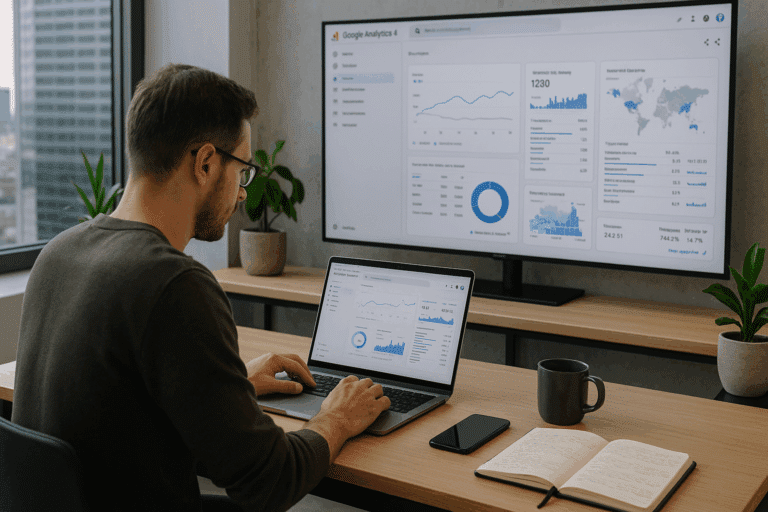The success of any online enterprise, including mobile applications, is often driven by a profound understanding of data and the ability to interpret and utilize it effectively. This is where Google Analytics comes into the picture, an absolute powerhouse of data analysis that can propel your mobile app performance to new heights. 🚀
Imagine having the ability to explore every nuance of user behavior on your app, from acquisition to retention, from user journey to churn rates, all at your fingertips. That’s what Google Analytics offers: a comprehensive, in-depth view of your mobile app’s performance, empowering you to make data-driven decisions.
However, as powerful as it is, Google Analytics can also be daunting, particularly if you’re not familiar with its complex interface or the myriad of data metrics it provides. But fear not! This guide is here to demystify Google Analytics, making it accessible, comprehensible, and, most importantly, usable. 🎯
What’s in Store?
This extensive guide will traverse the landscape of Google Analytics, shedding light on how to unlock its full potential to track and optimize your mobile app performance. We’ll kick off with an introduction to Google Analytics, covering what it is and why it’s essential for your mobile app. You’ll gain an understanding of how it functions and why it’s such a formidable tool in your app optimization toolkit.
Next, we’ll deep-dive into setting up Google Analytics for your mobile app. From creating a new account to configuring your first property, we’ll walk you through the process step by step. You’ll learn about the importance of views and filters, how to create and manage them, and their impact on your data reports. 🛠️
Once you’re set up, we’ll venture into the heart of Google Analytics – the metrics. This section will introduce you to the different types of metrics available, how to interpret them, and their significance for your mobile app performance. You’ll understand the difference between users and sessions, bounce rates and exit rates, and much more. 📊
The following section will dive into Google Analytics reports. These reports offer a wealth of information about your app users’ behavior, and we’ll help you understand how to read and analyze these reports to extract valuable insights.
Lastly, we’ll explore how to use Google Analytics to optimize your mobile app performance. You’ll discover how to track user engagement, identify bottlenecks, and devise strategies to improve user retention. All these learnings will equip you to make informed, data-driven decisions for your mobile app. 🌟
Whether you’re a seasoned app developer or a budding entrepreneur, this guide will offer you invaluable insights into the power of Google Analytics. So, let’s embark on this exciting journey to decode and leverage one of the most robust data analysis tools in the market today!
Unleash the Potential of Google Analytics: A Comprehensive Guide to Mobile App Performance Optimization
Every mobile application developer understands the significance of tracking app performance. In this rapidly evolving digital era, where mobile apps are no longer a luxury but a necessity, understanding how your app performs in real-world scenarios is crucial. Google Analytics is a powerful tool that offers insightful data, enabling you to enhance your app’s performance. This guide will delve into Google Analytics’ potential, providing a roadmap to optimize your mobile app’s performance like a pro.
Before we start, don’t miss the informative video: ‘Google Analytics for Beginners’ by Google Analytics on YouTube. It provides a comprehensive introduction to Google Analytics, perfect for beginners and experts alike.
Mastering Google Analytics for Mobile Apps
Google Analytics is an indispensable tool for app developers, helping to measure user engagement, user behavior, and much more. Understanding these metrics is critical to improving the overall user experience and performance of your mobile app. Here, we will explore the key features of Google Analytics that you should leverage to optimize your mobile app.
Real-Time Reporting: Google Analytics provides real-time reporting, enabling you to monitor user engagement and activity as it happens. You can see how many users are active on your app, the pages they’re viewing, and their geographical locations.
Demographics and Interests: With Google Analytics, you can gain insights into your users’ demographics, such as age, gender, and interests. This information can be instrumental in tailoring your app to meet your users’ preferences, enhancing user satisfaction and engagement.
Audience Segmentation
Google Analytics allows you to segment your users based on various criteria such as location, device, age, and behavior. This can be extremely beneficial for understanding your audience better and optimizing your app accordingly. For instance, if a particular demographic is highly active, you can focus your marketing efforts on them to increase engagement.
User Behavior
Knowing how users interact with your app is essential for improvement. Google Analytics provides detailed data on user behavior, such as the screens they visit, the actions they take, and the time they spend on your app. This information can help you identify any issues and improve the user experience.
Optimizing Mobile App Performance with Google Analytics
Now that you’re familiar with Google Analytics and its features, let’s look at how you can use it to optimize your mobile app’s performance. The following steps will guide you through the process:
Set Up Goals and Funnels
Goals in Google Analytics represent completed user activities that contribute to the success of your app. These could be anything from making a purchase, signing up for a newsletter, or completing a level in a game. You can also set up funnels to see the steps users take to complete a goal. This will help you identify any obstacles that might be preventing users from reaching their goals.
Track Key Performance Indicators (KPIs)
Identify and monitor the KPIs that are important to your app. These could be the number of downloads, user engagement, retention rate, or revenue. Tracking these metrics will give you an understanding of how well your app is performing and where improvements are needed.
Analyze and Act
Finally, use the data gathered from Google Analytics to make informed decisions and take action. Whether it’s redesigning a screen, fixing a bug, or launching a new marketing campaign, ensure your actions are driven by data.
Google Analytics for Mobile Apps: A Comparative Study
Google Analytics isn’t the only tool available for tracking mobile app performance, but it stands out due to its comprehensive features and easy integration. The table below compares Google Analytics with other popular analytics tools:
| Tool | Features | Integration | Pricing |
|---|---|---|---|
| Google Analytics | Real-time reporting, audience segmentation, user behavior tracking | Easy with Google Tag Manager | Free and paid versions available |
| Flurry Analytics | Session tracking, crash reporting, retention analysis | Requires SDK integration | Free |
| Mixpanel | Event tracking, funnel analysis, user segmentation | Requires SDK integration | Free and paid versions available |
Check out the video ‘Google Analytics vs. Mixpanel: A Comparative Analysis’ by Data Driven on YouTube for an in-depth comparison between these two powerful tools.
Take Your Mobile App Performance to the Next Level
Google Analytics is a potent tool that can give you a wealth of information about your mobile app’s performance. By understanding your users, tracking your KPIs, and analyzing your data, you can make informed decisions to optimize your app. Remember, data-driven decision making is key to the success of any mobile app. Start using Google Analytics today and unlock your mobile app’s potential!

Conclusion
In conclusion, the application and exploration of the principles and methodologies of software engineering are more crucial than ever in today’s increasingly tech-driven landscape. This article has endeavored to encapsulate some of the key aspects and intricacies of software engineering, from design and coding to testing, maintenance, and beyond. It is hoped that the clarity and precision in the presentation of these topics will further equip readers to better appreciate and apply these principles in their respective spheres of influence.
Throughout this article, we have discussed the importance of understanding the software development life cycle (SDLC), with its various stages of requirement gathering, designing, coding, testing, and maintenance. We delved into different programming paradigms like procedural, object-oriented, and functional programming and how they shape the way we develop software today.
We also explored various software testing techniques and their importance in maintaining software quality. Furthermore, we scrutinized the role of software maintenance in ensuring software longevity and adaptability to meet changing user requirements. 🛠️
The profound knowledge of project management methodologies such as Waterfall, Agile, and DevOps was also emphasized, highlighting how they can transform the way software projects are planned, executed, and delivered. We also delved into the significance of version control systems like Git in facilitating collaboration and ensuring code integrity. 🚀
Emphasizing the importance of well-written code, we have also highlighted the concept of clean code and its principles. We have discussed how following these principles not only helps in developing efficient software but also fosters a productive and collaborative environment among developers. 📝
This article, however, is just the tip of the iceberg when it comes to the vast and intriguing world of software engineering. As technology continues to evolve at a rapid pace, so too does the field of software engineering. It is therefore paramount to stay abreast of these changes and continually sharpen your skills.
The power of software engineering lies in its ability to solve complex problems and make our lives easier. The impact of this field is vast and far-reaching, and it continues to shape our world in ways we couldn’t have imagined just a few decades ago. 🌐
We welcome you to continue this journey of discovery and learning. Feel free to comment, share, and apply the knowledge gleaned from this article. We also encourage you to explore other reputable resources to further broaden your understanding. Here are some great places to start:
– [IEEE Software Engineering](https://www.computer.org/technical-committees/software-engineering/)
– [ACM Special Interest Group on Software Engineering](https://www.sigsoft.org/)
– [Software Engineering Institute at Carnegie Mellon University](https://www.sei.cmu.edu/)
Remember, the journey of a thousand miles begins with a single step. So, take that step today and venture into the fascinating world of software engineering. Your journey to becoming a software engineering maven starts here! 💡💻🌟
Finally, stay tuned for more articles that delve deeper into these topics. If there are any specific areas you would like us to cover, please let us know in the comments section. Happy coding, and remember – the sky is the limit!



